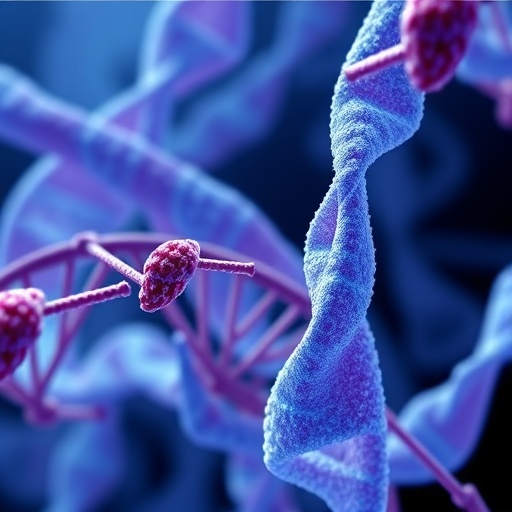In a groundbreaking study poised to reshape the landscape of cancer therapeutics, researchers have uncovered an unprecedented mechanism by which the small molecule inhibitor PF-3758309 exerts its potent anti-tumor effects. Leveraging a multi-omics approach, the international research team identified that PF-3758309 triggers the degradation of RNA polymerase II, a critical enzyme in the transcription machinery, thereby silencing oncogenic gene expression and halting tumor progression. This fresh insight opens new avenues for targeted cancer treatment, positioning RNA polymerase II degradation as a novel and exploitable vulnerability within malignant cells.
Cancer remains a formidable global health challenge, with molecular complexity and adaptability often undermining therapeutic efficacy. Traditional strategies targeting kinases or DNA replication have delivered significant benefits but are frequently thwarted by acquired resistance. PF-3758309, initially characterized as a potent inhibitor of PAK4 (p21-activated kinase 4), has demonstrated robust anti-cancer activity across various tumor models. However, its precise mechanisms had remained elusive, preventing the refinement and broader application of this compound in clinical oncology. The new research provides a pivotal mechanistic understanding that could accelerate the development of PF-3758309-based therapies.
The research team applied a comprehensive multi-omics workflow integrating transcriptomics, proteomics, and ubiquitin-proteomics to decode the cellular response landscape evoked by PF-3758309 treatment. This integrative approach enabled the delineation of complex molecular interactions and regulatory networks influenced by the drug. Strikingly, the data revealed substantial downregulation of RNA polymerase II subunits at the protein level, accompanied by enhanced ubiquitination signaling, a hallmark of targeted protein degradation pathways. These findings implicated the ubiquitin-proteasome system in orchestrating the removal of RNA polymerase II under pharmacological pressure.
Further mechanistic investigations revealed that PF-3758309 treatment enhances the activity of specific E3 ubiquitin ligases that tag RNA polymerase II with ubiquitin moieties. This post-translational modification earmarks the enzyme for proteasomal degradation. The study identified candidate E3 ligases implicated in this process, highlighting a cascade wherein PF-3758309 indirectly engages the ubiquitin machinery to target transcriptional apparatus for destruction. This intricate crosstalk underscores the sophistication of the drug’s mode of action beyond straightforward enzyme inhibition.
Functional assays underscored the biological consequences of RNA polymerase II degradation in cancer cells. Treated tumor cells exhibited profound transcriptional repression, leading to cell cycle arrest and apoptotic cell death. Importantly, the selectivity of PF-3758309 towards malignant cells versus normal cells was confirmed, suggesting a therapeutic window that could minimize off-target toxicity. This selectivity likely stems from the heightened dependency of tumor cells on robust transcriptional programs to sustain their uncontrolled growth.
The researchers extended their findings across multiple cancer types, including breast, lung, and colon carcinomas, demonstrating consistent RNA polymerase II degradation upon PF-3758309 exposure. This broad-spectrum effect indicates that the molecular vulnerability targeted by the compound is conserved across diverse malignant contexts. Such versatility makes PF-3758309 a promising candidate for further preclinical and clinical evaluation in heterogeneous tumor settings.
This study also employed in vivo murine xenograft models to validate the anti-tumor efficacy of PF-3758309 in a physiological context. Tumor-bearing mice receiving the compound showed significant tumor volume reduction, correlating with decreased RNA polymerase II expression in tumor tissues. The in vivo results corroborate the in vitro mechanistic insights, reinforcing the potential translational impact of RNA polymerase II degradation-driven therapeutic strategies.
Importantly, the identification of RNA polymerase II as a degradation target raises compelling questions about the cellular stress responses activated by transcriptional collapse. The researchers observed induction of DNA damage response pathways and signaling alterations linked to the unfolded protein response, illustrating a complex network of adaptive and lethal processes triggered by PF-3758309. Further exploration of these secondary effects could inform combination treatment regimens that amplify anti-tumor efficacy.
Advancing from discovery to therapeutic application will require overcoming potential challenges related to specificity and the development of resistance mechanisms. As RNA polymerase II is a fundamental cellular component, prolonged inhibition or degradation could risk toxicity in highly proliferative normal tissues. The partial selectivity observed in cancer cells offers optimism, but the therapeutic window must be rigorously defined through dose optimization and biomarker development to identify responsive patient populations.
The study’s multi-omics approach serves as a model for future drug mechanism investigations, illustrating how integrated analyses can unravel complex pharmacodynamics. By converging data across molecular layers, the researchers provided a comprehensive overview of how PF-3758309 reprograms cancer cell transcriptional machinery, challenging conventional drug characterization paradigms. This methodological advance will likely propel the discovery of analogous pathways in other compounds with elusive targets.
Looking ahead, the therapeutic exploitation of RNA polymerase II degradation invites exciting prospects beyond oncology. Since transcriptional deregulation underpins diverse pathological conditions, the principles uncovered here may inform strategies against viral infections or inflammatory diseases where aberrant gene expression is pathogenic. Moreover, harnessing the ubiquitin-proteasome system to degrade nuclear enzymes represents a fertile ground for drug development expanding the repertoire of ‘degrader’ molecules beyond current technologies like PROTACs.
The reported findings have already sparked significant interest within the scientific and pharmaceutical communities. By elucidating a novel mechanism of action for PF-3758309, this work invigorates efforts to design next-generation transcription-targeting agents that combine potency with specificity. The path from bench to bedside could be accelerated by leveraging structural biology insights and chemical optimization to enhance drug-like properties and minimize adverse effects.
In summary, the revelation that PF-3758309 induces the degradation of RNA polymerase II presents a transformative concept in cancer therapy. This mechanism disrupts the very foundation of cancer cell survival—the transcriptional machinery—thereby offering a potent strategy to impede tumor growth. The study’s comprehensive multi-omics analysis not only deepens our understanding of PF-3758309’s anti-tumor activity but also highlights the broader therapeutic potential of regulating RNA polymerase II stability. As research continues, this discovery may herald a new class of targeted treatments with profound clinical impact.
Subject of Research: Molecular mechanisms underlying the anti-tumor activity of PF-3758309, focusing on transcriptional machinery disruption.
Article Title: Multi-omics analysis reveals RNA polymerase II degradation as a novel mechanism of PF-3758309’s anti-tumor activity.
Article References:
Jia, X., Zhang, J., Pan, L. et al. Multi-omics analysis reveals RNA polymerase II degradation as a novel mechanism of PF-3758309’s anti-tumor activity. Cell Death Discov. 11, 404 (2025). https://doi.org/10.1038/s41420-025-02677-5
Image Credits: AI Generated
DOI: https://doi.org/10.1038/s41420-025-02677-5
Tags: cancer research breakthroughsmechanisms of cancer drug actionmulti-omics approach in cancer researchnovel cancer therapeutic vulnerabilitiesoncogenic gene expression silencingovercoming cancer therapeutic resistancePAK4 kinase inhibitionPF-3758309 anti-tumor effectsPF-3758309 clinical applicationsRNA polymerase II degradationtargeted cancer treatment strategiestranscriptomics and proteomics integration





